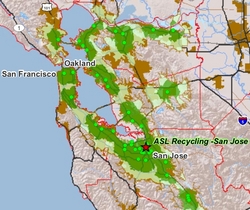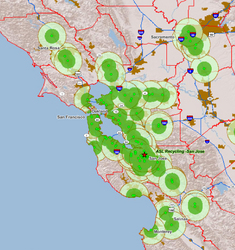
San Jose, CA (Vocus) May 6, 2008
ASL Recycling’s GREENetwork continued to grow during April with the addition of 19 GREENspot e-waste drop-off locations, bringing the total number in Northern California to 90. Now most residents can find a free place to dispose of their obsolete electronics close to their home–in most cases within five miles. As consumer awareness of these free and convenient neighborhood locations builds–especially since the GREENetwork’s Earth Day campaign to encourage people to find their GREENspot location last month–hundreds of residents are visiting a neighborhood GREENspot location, resulting in almost four million pounds of e-waste being diverted away from local landfills so far, this year.
Unlike other recyclable waste, there is no ‘blue bin’ equivalent for curbside collection of e-waste, and so, until recently, most people didn’t know what to do with it. ASL Recycling is changing that by establishing a statewide network of GREENspot e-waste drop-off locations, and by orchestrating locally focused public awareness campaigns. Californians can visit to find a nearby e-waste drop-off location.
“We want to make it as easy to recycle an old gadget as it is to buy a new one,” said Carey Levine, vice president of sales and marketing at ASL Recycling. “What we hear from consumers is that they want to do the right thing and dispose of their e-waste responsibly, but they’re concerned about their personal data or how the e-waste is being recycled. When you select a GREENspot you can be sure that you’re working with a reputable e-waste collector.”
19 new GREENspot e-waste drop-off locations opened in April
This month, 19 new GREENspot e-waste drop-off locations were established in Northern California, bringing the total to 91 statewide. The new locations added to the GREENetwork in April are available as an attachment.
What to recycle, and why
E-waste accepted at GREENspot drop-off locations includes TVs, cell phones, audio-video components, computer equipment, microwave ovens, electronic equipment from offices and labs, and more. These items are potentially toxic to the environment and by choosing to recycle them, Californians can help divert e-waste from landfills. All GREENspot drop-off locations feed their e-waste to ASL Recycling’s state-approved plants, which use an environmentally friendly e-waste recycling process.
Where to recycle e-waste
A complete list of ASL GREENspot drop-off locations is available here.
E-waste and the law
E-waste, which includes TVs, monitors, computers, cell phones, and other old electronics, is the fastest-growing category of solid waste in the United States. California is leading the nation with its Electronic Waste Recycling Act, the state’s e-waste recycling legislation. The state’s Department of Toxic Substance Control has stated that video display devices are hazardous waste and are covered by the Electronic Waste Recycling Act. This means it is illegal to discard the following devices in household and business trash:
—

